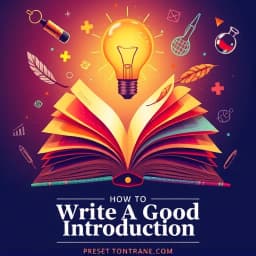
How to Write a Good Introduction for a Research Paper
Find this useful? Bookmark ( CTRL/CMD + D ) for quick access!
Try an example:
Academic Research Papers
Thesis Introductions
Literature Review Openings
Scientific Journal Articles
Dissertation Proposals
Conference Paper Intros
Explore Similar Tools
Recent Generations
the amount paid directly to you. Yes it is possible in future cases to request direct payment to the provider, Rephrase and give me polished email.
we have processed the claim as per the attachments in the claim submission we have processedthe invoice for Saul Holding. We dont have invoice for the Salofalk.
this additional information is very important. this adiitional information was requested by our clinical team. Without clinical review claim not be paid so please share the below additional information
How To Write A Good Introduction For A Research Paper
How To Write A Good Introduction For A Research Paper is a powerful AI-powered writing assistant that helps users craft compelling and effective introductions for their research papers. This innovative solution combines advanced natural language processing with expert writing techniques to deliver engaging and informative opening paragraphs that captivate readers and set the stage for the research that follows.
Key Capabilities
- Guided Writing Prompts that help users brainstorm and structure their introduction, ensuring clarity and coherence.
- Research Integration enabling seamless incorporation of relevant literature and citations, enhancing the credibility of the introduction.
- Tone and Style Suggestions for tailoring the introduction to meet academic standards and align with the target audience's expectations.
- Real-time Feedback that provides instant suggestions for improvement, helping users refine their writing on the go.
Who It's For
Designed for students, researchers, and academics, How To Write A Good Introduction For A Research Paper excels in creating high-quality introductions for various disciplines. Whether you're drafting a thesis, a journal article, or a conference paper, this tool streamlines your writing process and enhances the overall quality of your work.
Why Choose How To Write A Good Introduction For A Research Paper
What sets How To Write A Good Introduction For A Research Paper apart is its unique blend of AI technology and writing expertise, making it the ideal solution for anyone looking to improve their academic writing skills and produce impactful research introductions.
Ready to transform your research writing? Start using How To Write A Good Introduction For A Research Paper today and experience the difference in your academic journey!
Enhance Your Work with How to Write a Good Introduction for a Research Paper
Leverage the power of AI to streamline your tasks with our How to Write a Good Introduction for a Research Paper tool.
Guided Structure
Receive step-by-step guidance on how to structure your introduction effectively, ensuring clarity and coherence.
Customizable Templates
Access a variety of customizable templates tailored to different research fields, making it easy to start your introduction.
Idea Generation
Utilize AI-driven suggestions to brainstorm and refine key ideas that will engage your readers from the outset.
How How to Write a Good Introduction for a Research Paper Works
Discover the simple process of using How to Write a Good Introduction for a Research Paper to improve your workflow:
Input Your Topic
Enter the main topic or question of your research paper to guide the introduction.
Select Key Points
Choose the key points and arguments you want to highlight in your introduction.
AI Generation
Our AI tool generates a well-structured introduction based on your inputs.
Review and Edit
Review the generated introduction and make any necessary edits to personalize it.
Use Cases of
How to Write a Good Introduction for a Research Paper
Explore the various applications of How to Write a Good Introduction for a Research Paper in different scenarios:
Academic Writing Assistance
Provide students and researchers with guidelines and examples for crafting effective introductions that engage readers and clearly present research objectives.
Research Proposal Development
Help researchers formulate compelling introductions for their proposals, ensuring they highlight the significance of their research questions and the context of their studies.
Publication Preparation
Assist authors in preparing their manuscripts for journal submission by offering strategies for writing strong introductions that meet publication standards and attract editorial interest.
Teaching Tool for Writing Courses
Serve as a resource for educators teaching writing courses, providing structured approaches to help students understand the components of a good introduction in research papers.
Who Benefits from How to Write a Good Introduction for a Research Paper?
AI-Powered Efficiency
From individuals to large organizations, see who can leverage How to Write a Good Introduction for a Research Paper for improved productivity:
Students
Learn how to craft compelling introductions that engage readers and set the stage for their research.
Researchers
Enhance the quality of their research papers by mastering the art of writing effective introductions.
Educators
Provide students with guidance on writing strong introductions, improving overall academic writing skills.
Academic Advisors
Support students in developing their writing skills, ensuring they understand the importance of a strong introduction.
Frequently Asked Questions
What is the purpose of the AI tool 'How To Write A Good Introduction For A Research Paper'?
The purpose of this AI tool is to assist researchers and students in crafting effective and engaging introductions for their research papers, ensuring they capture the reader's attention and clearly outline the paper's objectives.
Can the AI tool help with specific formatting styles?
Yes, the AI tool can provide guidance on various formatting styles such as APA, MLA, and Chicago. It can help you structure your introduction according to the specific requirements of your chosen style.
Is the AI tool suitable for all academic disciplines?
Absolutely! The AI tool is designed to cater to a wide range of academic disciplines, providing tailored suggestions that align with the conventions and expectations of different fields of study.
How does the AI generate suggestions for introductions?
The AI analyzes existing research papers and academic writing principles to generate suggestions. It uses natural language processing to understand context and provide relevant content that enhances the quality of your introduction.
Can I use the AI tool for multiple drafts of my introduction?
Yes, you can use the AI tool for multiple drafts. It allows you to refine and improve your introduction iteratively, providing new suggestions and insights with each revision to help you achieve the best possible outcome.































